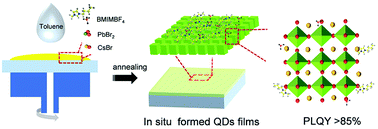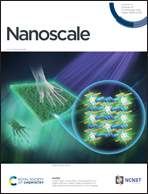Ionic liquid-induced in situ deposition of perovskite quantum dot films with a photoluminescence quantum yield of over 85%†
Abstract
Metal halide perovskite quantum dots (QDs) hold great promise as building blocks for next-generation light emitting devices (LEDs). The preparation of perovskite QD films with high photoluminescence quantum yield (PLQY) is the key to realizing efficient LEDs. However, the conventional deposition method of spin-coating of pre-synthesized QD ink solutions results in perovskite QD films with low PLQY (typically <45%) due to non-radiative recombination centers induced in the deposition process. Here, by utilizing the ionic nature and steric hindrance effect of the ionic liquid, we demonstrate an in situ deposition method for perovskite QD films with high PLQY by directly spin-coating precursor solutions containing an ionic liquid. Furthermore, mechanistic study reveals that the ionic liquid not only induces the formation of QDs but also suppresses defect-related recombination through the interaction with uncoordinated metal atoms on the surface of the QDs. As a result, the in situ deposited CsPbBr3 QD film with a PLQY as high as 85.2% and long-term air stability is achieved. These findings demonstrate that the introduction of an ionic liquid provides an effective strategy to enhance the performance of in situ formed perovskite QD films, which could benefit the development of efficient LEDs and other optoelectronic devices.



 Please wait while we load your content...
Please wait while we load your content...